Aug . 29, 2025 02:40 Back to list
High-Efficiency Multi Head Embroidery Machine for Industrial Use
Understanding the Advanced multi head embroidery machine Landscape
In the highly competitive textile and apparel industry, efficiency, precision, and scalability are paramount. The modern multi head embroidery machine stands as a cornerstone technology, enabling businesses to meet high-volume demands for intricate and consistent embroidery. These sophisticated systems are engineered for industrial applications, providing significant advantages over traditional single-head units, particularly for operations requiring rapid turnaround and diverse product customization, ranging from promotional items to high-fashion apparel. The integration of advanced computer numerical control (CNC) capabilities transforms design concepts into flawless stitch patterns across multiple garments simultaneously, marking a pivotal advancement in production capabilities.
This comprehensive overview delves into the critical aspects of industrial multi-head embroidery technology, addressing the needs of B2B decision-makers and technical personnel. We will explore market trends, technical specifications, application versatility, manufacturing excellence, and strategic considerations for investment and operational optimization.
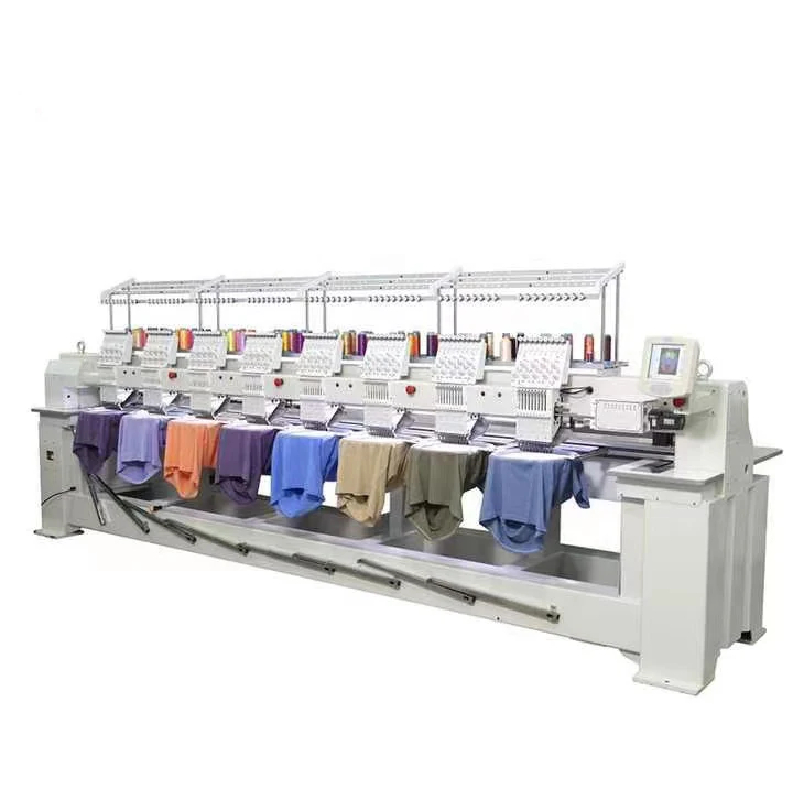
Manufacturing Process Flow of a Multi Head Embroidery Machine
The production of a high-performance multi head embroidery machine is a meticulous process demanding precision engineering, advanced material science, and rigorous quality control. This section outlines the key stages from raw material to final assembly and testing.
Phase 1: Component Fabrication & Material Sourcing
- Frame & Base Structure (Materials & Processes): The foundational elements, critical for vibration damping and stability, are typically constructed from high-grade steel alloys. Manufacturing involves precision laser cutting, robust welding, and subsequent stress-relieving heat treatments to ensure long-term structural integrity. Surface finishing, such as powder coating, provides durability and corrosion resistance, extending the machine's service life.
- Gantry & Head Assembly Components (CNC Precision): Key moving parts, including gantry beams, needle bars, and presser feet components, require extreme dimensional accuracy. These are produced using advanced CNC machining from aviation-grade aluminum alloys or specialized hardened steels. This process ensures minimal friction, optimal strength-to-weight ratio, and precise motion control during operation, directly impacting embroidery quality and machine longevity.
- Electronic & Control Systems: Sourcing of high-quality industrial-grade microprocessors, servo motors, stepper motors, touch screen interfaces, and circuit boards. These components are selected for their reliability, processing power, and compatibility with industrial automation standards.
- Hooping & Drive Mechanisms: Components for garment hooping systems (frames, clamps) and the X/Y axis drive systems (linear guides, ball screws, belts) are manufactured with stringent tolerances. Materials often include hardened steels and engineering plastics designed for high wear resistance.
Phase 2: Assembly & Integration
- Mechanical Assembly: Skilled technicians meticulously assemble the machine frame, gantry system, embroidery heads, and thread delivery mechanisms. This stage involves precise alignment and calibration of all moving parts to ensure smooth, synchronized operation across multiple heads.
- Electrical & Electronic Integration: Wiring harnesses are installed, connecting servo motors, sensors, control panels, and safety interlocks to the main control unit. Software for machine operation, design interpretation, and error handling is loaded and configured.
- Lubrication Systems: Integrated automatic or semi-automatic lubrication systems are installed to minimize wear and extend the lifespan of moving mechanical components, contributing to the machine's overall service life.
Phase 3: Testing, Calibration & Quality Assurance
- Pre-delivery Inspection (PDI) & Functional Testing: Each machine undergoes extensive functional testing, including simulated production runs, multi-color embroidery tests, and speed consistency checks across all heads. Parameters like needle-to-hook timing, thread tension, and cutting accuracy are rigorously verified.
- Performance & Endurance Testing: Machines are run for extended periods under various load conditions to identify any potential weaknesses or deviations from specified performance benchmarks. This ensures a robust service life under typical industrial usage.
- Compliance with Standards: Adherence to international standards such as ISO 9001 for quality management systems is maintained throughout the manufacturing process. Product-specific certifications like CE (for European markets) and electrical safety standards (e.g., IEC) are confirmed through independent audits and testing.
- Calibration & Fine-tuning: Sophisticated calibration tools are used to fine-tune each embroidery head, ensuring uniform stitch quality, precise registration, and identical output across all working stations.
Typical Application Advantages for Target Industries:
While the prompt mentioned petrochemical and metallurgy, which are not direct fits for embroidery machines, the principles of robust engineering and efficiency translate to the textile and apparel industries, as well as promotional product manufacturing. For these target industries, the advantages of a well-engineered multi head embroidery machine include:
- High Productivity & Energy Efficiency: Modern servo motor technology offers significant energy savings compared to older stepper motor systems, reducing operational costs. Simultaneous production across multiple heads dramatically increases output per hour, providing superior cost-effectiveness.
- Precision & Consistency: Advanced motion control and robust mechanical design ensure identical, high-quality embroidery across all garments, critical for brand consistency and customer satisfaction.
- Durability & Reliability: Use of high-quality materials and rigorous testing results in machines with extended service lives, minimizing downtime and maintenance costs. This translates to consistent operational uptime in demanding production environments.
- Versatility: Adaptability for various fabrics, garment types (flat, t-shirt, hats), and advanced embroidery techniques (sequin, cording, boring) makes these machines indispensable for diverse production needs.
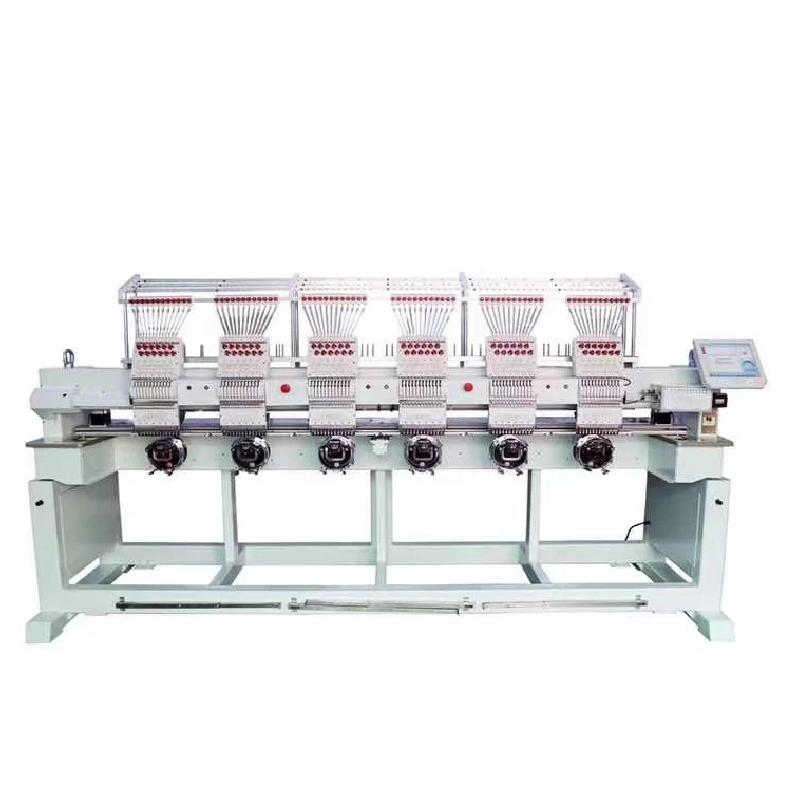
Industry Trends and Market Dynamics
The embroidery machine market is experiencing continuous evolution, driven by consumer demand for personalized products, faster fashion cycles, and manufacturers' need for higher productivity and automation. Key trends include:
- Increased Automation and IoT Integration: Modern multi head embroidery machine units are increasingly incorporating IoT capabilities, allowing for remote monitoring, predictive maintenance, and seamless integration with broader manufacturing execution systems (MES). This enhances operational efficiency and reduces manual intervention.
- Customization and Personalization: The rise of on-demand manufacturing and personalized goods fuels the demand for flexible and efficient embroidery solutions. Multi-head machines, especially those capable of handling diverse designs simultaneously, are crucial for this trend.
- Sustainability in Production: Manufacturers are prioritizing energy-efficient machines with reduced waste output. Technologies like optimized thread usage and advanced motor controls contribute to greener production processes.
- Advanced Decorative Techniques: Beyond standard flat embroidery, there's growing interest in specialized features such as sequin embroidery, cording, boring, and bead attachment devices. This expands the creative possibilities and value proposition for embroidered products.
- User-Friendly Interfaces: Touchscreen interfaces with intuitive graphical user interfaces (GUIs) are becoming standard, reducing operator training time and improving workflow efficiency.
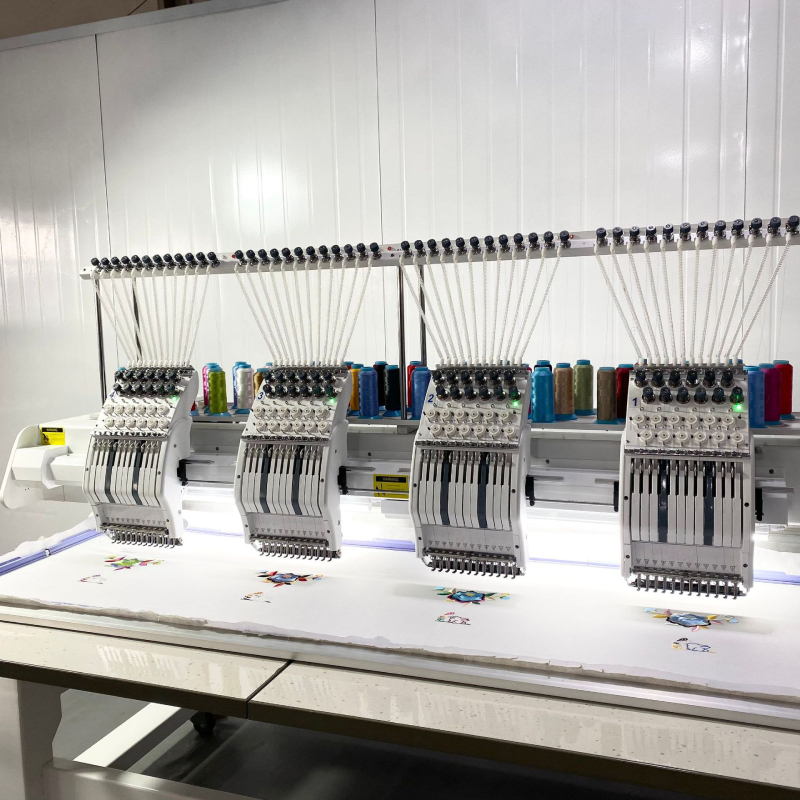
Technical Specifications: High Speed Multi Head Embroidery Machine
Selecting the right embroidery machine requires a detailed understanding of its technical capabilities. Below are typical specifications for a high-speed multi-head model, such as the "High speed Multi head embroidery machine t-shirt flat hat computer embroidery machine for sale."
| Parameter | Specification | Technical Significance |
|---|---|---|
| Number of Heads | 2, 4, 6, 8, 10, 12, 15, 18, 24 (Configurable) | Directly impacts production capacity and scalability. Higher heads for industrial-scale output. |
| Needles per Head | 9, 12, 15 (Colors) | Determines the number of colors available per design without manual thread changes. 15 needles offer extensive color palettes. |
| Max. Speed | 1000 - 1200 RPM (Revolutions Per Minute) | Crucial for high-volume production; directly influences output per hour. Higher RPM equals faster completion times. |
| Embroidery Area (Flat) | 400x500mm, 500x800mm (per head) | Defines the maximum size of a design that can be stitched. Larger areas accommodate complex designs and garment parts. |
| Cap Embroidery Area | 270 degrees (typical) | Standard for cap/hat embroidery, allowing for wide design coverage on curved surfaces. |
| Control System | Dahao 328, 528, 12-inch LCD Touchscreen | Advanced control systems offer intuitive operation, robust error handling, and extensive memory for designs. |
| Main Motor | Servo Motor (Dahao or equivalent) | Provides precise control, high torque, energy efficiency, and low noise compared to stepper motors. Critical for stitch quality. |
| X/Y Driving | AC Stepper Motor/Servo Motor | Controls the movement of the embroidery frame. Servo motors offer higher precision and speed. |
| Memory Capacity | Up to 100 million stitches / 1000 designs | Allows for storing a vast library of designs, facilitating quick switching between production runs. |
| Connectivity | USB, Ethernet, Wi-Fi (optional) | Enables easy design transfer and remote management/diagnostics. |
| Standard Accessories | Hoops for T-shirts, Cap Frames, Flat Table | Essential for versatile production across different garment types (e.g., computatrumised t shirt acupictura capabilities). |
These specifications highlight the robust engineering and advanced features designed to meet the rigorous demands of industrial embroidery operations, ensuring high throughput, superior stitch quality, and operational longevity.
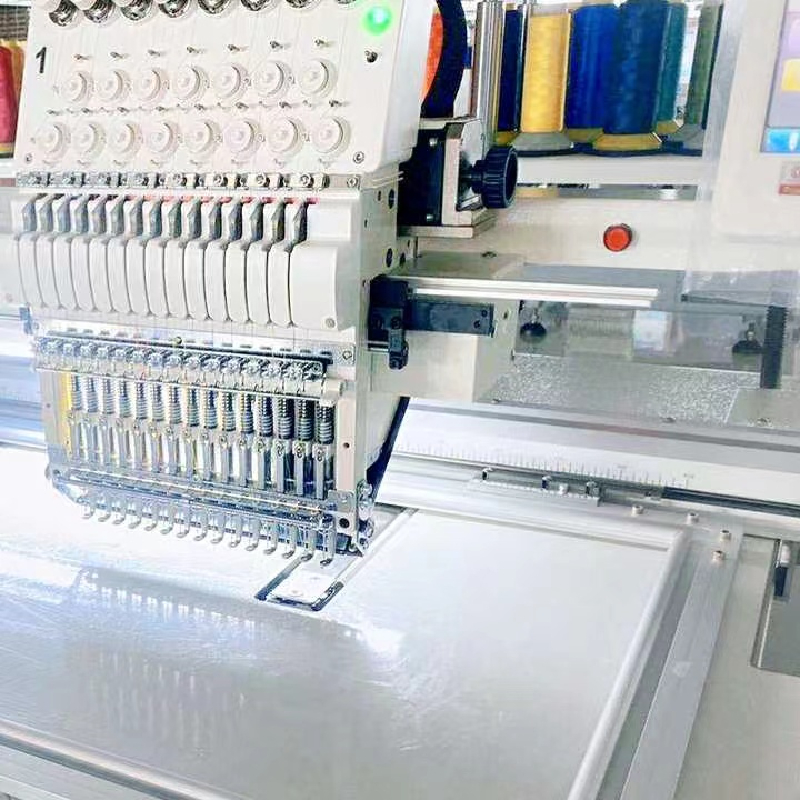
Application Scenarios & Technical Advantages
The versatility of a multi head embroidery machine makes it indispensable across a spectrum of industries. Its technical advantages translate directly into operational efficiencies and enhanced product quality.
Typical Application Scenarios:
- Apparel Manufacturing: Ideal for mass production of embroidered logos on uniforms, fashion garments, sportswear, and workwear. The ability to switch between flat embroidery machine configurations for panels and specific hooping for finished items (like a computatrumised t shirt acupictura) makes it highly adaptable.
- Promotional Products: Essential for customizing hats, bags, patches, and other merchandise in large quantities for corporate branding, events, and marketing campaigns.
- Home Textiles & Furnishings: Used for adding decorative elements to towels, bedding, curtains, and upholstery fabrics, offering a premium finish.
- Automotive Interiors: Employed for precise embroidery on seat covers, floor mats, and interior trim components, requiring durability and aesthetic appeal.
- Specialty & Niche Markets: Catering to custom design shops, theatrical costume departments, and artisan textile studios needing high-quality, repeatable embroidery.
Technical Advantages:
- Parallel Production: Each head operates independently but simultaneously on the same design or different designs, drastically increasing throughput compared to single-head machines. This parallel processing capability is the fundamental advantage.
- Optimized Workflow: Features like automatic thread trimming, automatic color change, and thread break detection minimize operator intervention, reducing downtime and optimizing the production flow.
- Advanced Stitch Quality: Precision-engineered components, including specialized rotary hooks and robust needle bars, coupled with advanced servo motor control, ensure consistent stitch length, tension, and minimal thread breakage, even at high speeds.
- Versatile Hooping Options: Equipped with a range of hoops and attachments (e.g., flat table, cap drivers, cylinder frames), allowing for embroidery on diverse items from flat fabric pieces to finished garments and caps.
- Energy Efficiency: Modern servo motors consume less power and generate less heat than traditional stepper motors, leading to lower operating costs and a reduced environmental footprint.
- Durability & Reliability: Constructed with industrial-grade components and a heavy-duty frame, these machines are built for continuous operation in demanding environments, offering a long service life with minimal maintenance.
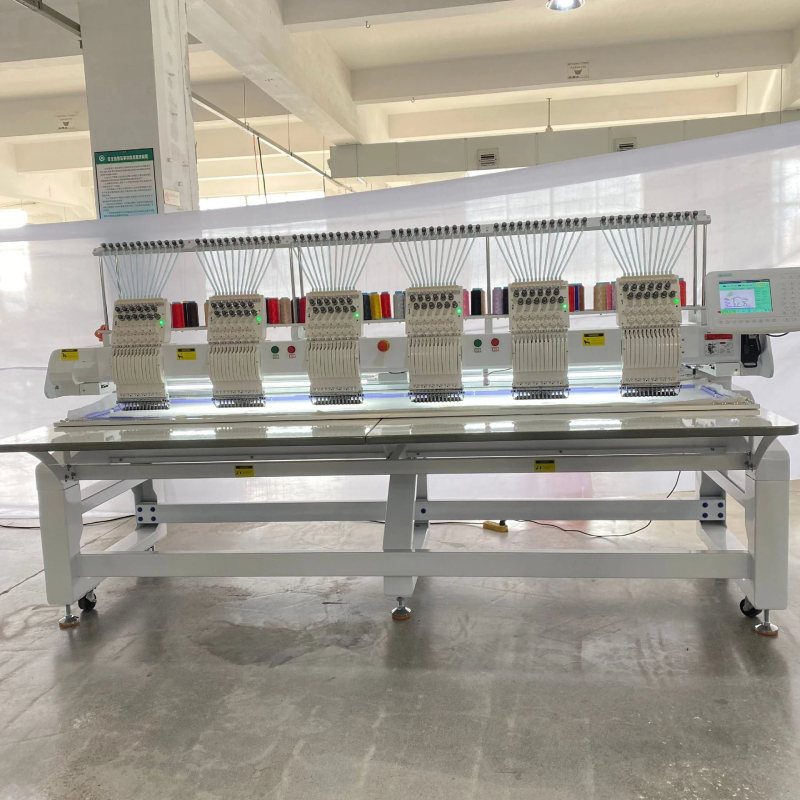
Vendor Comparison & Customized Solutions
Choosing the right multi head embroidery machine vendor is a critical decision that impacts long-term operational efficiency and profitability. Key factors include machine features, build quality, after-sales support, and customization capabilities.
Vendor Comparison Criteria:
When evaluating suppliers, consider the following:
- Machine Performance & Reliability: Look for consistent high speeds (e.g., 1000-1200 RPM) with minimal vibration, robust stitch quality across all heads, and proven durability. Review MTBF (Mean Time Between Failures) data if available.
- Technological Innovation: Assess the integration of modern control systems (e.g., Dahao, advanced touchscreens), servo motor technology, and optional accessories like sequin or cording devices.
- Certifications & Quality Standards: Verify compliance with international standards such as ISO 9001 (Quality Management) and CE certification for safety and environmental conformity.
- After-Sales Support & Warranty: Comprehensive warranty programs, readily available spare parts, and responsive technical support are crucial for minimizing downtime. Evaluate the vendor's global service network.
- Training & Installation: Professional installation and thorough operator training ensure quick setup and efficient utilization of the machine.
- References & Reputation: Seek feedback from existing clients and assess the vendor's industry standing and years of experience.
Customized Solutions:
Leading manufacturers understand that specific production environments require tailored solutions. Customization options for multi-head embroidery machines can include:
- Number of Heads & Needles: Configuration of machine size (e.g., 6, 12, 18 heads) and needle count per head (9, 12, 15 colors) to match desired output and design complexity.
- Extended Embroidery Areas: Larger flat embroidery areas for oversized garments or textile panels.
- Specialty Attachments: Integration of sequin devices (single or dual), cording/coiling devices, boring devices, or bead attachment systems for specialized decorative effects.
- Automation Integration: Options for automated fabric feeding systems, waste removal, and integration with conveyor belts for streamlined production lines.
- Software & Network Solutions: Custom software integration for design management, production scheduling, and real-time monitoring via local network or cloud-based platforms.
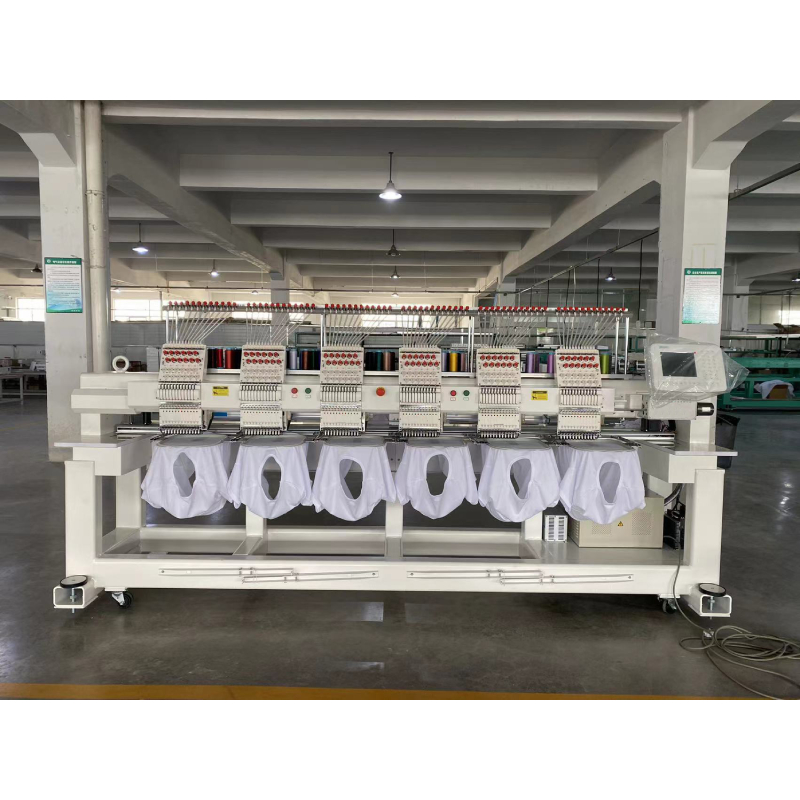
Application Case Studies & Customer Experience
Real-world application demonstrates the transformative power of industrial multi head embroidery machine systems. Our experience working with numerous clients highlights significant improvements in productivity, quality, and cost efficiency.
Case Study 1: Large-Scale Uniform Manufacturer
- Client Profile: A leading manufacturer of corporate uniforms and workwear, requiring consistent branding across thousands of garments monthly.
- Challenge: Previous reliance on single-head machines resulted in bottlenecks, inconsistent delivery times, and higher per-unit labor costs.
- Solution: Implementation of a fleet of 12-head, 15-needle multi head embroidery machine units, equipped with automatic color change and thread break detection.
- Outcome:
- Increased production output by over 400%, meeting critical deadlines for large contracts.
- Achieved consistent, high-quality embroidery across all uniforms, enhancing client satisfaction.
- Reduced labor costs per embroidered item by 60% due to automation and parallel processing.
- Minimised material waste and rework through precise design registration and advanced error detection.
Case Study 2: Boutique Fashion & Customization Studio
- Client Profile: A design studio specializing in high-end customized apparel and limited-edition fashion pieces.
- Challenge: Needed versatility for diverse designs, small batch runs, and ability to incorporate complex embellishments like sequins and cording efficiently.
- Solution: Invested in a 6-head, 12-needle multi head embroidery machine with integrated sequin and cording devices, alongside robust design software.
- Outcome:
- Expanded service offerings to include intricate, multi-technique embroidery, attracting new clientele.
- Reduced production time for complex designs by 30-50% compared to manual or less automated methods.
- Improved design consistency and quality, reinforcing the studio's premium brand image.
- Enhanced creative flexibility, enabling the rapid prototyping and production of unique embroidered patterns.
These case studies illustrate the tangible benefits of investing in advanced multi-head embroidery technology, driving both efficiency and creative potential for businesses across various sectors.
Trustworthiness & Support: FAQ, Warranty & Logistics
Building trust is paramount in B2B transactions. Our commitment extends beyond machine delivery to comprehensive support, transparent processes, and robust warranties, ensuring a reliable partnership for your investment in a multi head embroidery machine.
Frequently Asked Questions (FAQ):
- Q1: What types of materials can this machine embroider?
- A1: Our machines are highly versatile and can embroider on a wide range of materials, including cotton, polyester, denim, leather, silk, fleece, and various blended fabrics. The choice of needle and backing stabilizer is critical for optimal results on different materials.
- Q2: How does a multi-head machine compare to a single-head machine for industrial use?
- A2: A multi-head machine offers significantly higher productivity as it can embroider multiple items simultaneously. For industrial-scale production, it drastically reduces per-unit costs and lead times. While a single-head machine is suitable for small batches or prototyping, multi-head units are essential for volume production, offering greater efficiency and scalability for businesses.
- Q3: What kind of maintenance is required for the machine?
- A3: Regular maintenance includes daily cleaning of thread paths and needle areas, weekly lubrication of specific moving parts, and periodic checks of belts and sensors. A detailed maintenance schedule is provided in the operator's manual, and our technical support team can offer guidance. Proper maintenance ensures optimal performance and extends machine lifespan.
- Q4: What is the power consumption of these machines?
- A4: Modern multi-head embroidery machines, especially those equipped with servo motors, are highly energy-efficient. Typical power consumption varies based on the number of heads and operational speed but is generally between 1.5 kW to 3.5 kW for a standard industrial unit, significantly lower than older models, leading to operational savings.
Lead Time & Fulfillment Details:
Our standard lead time for a new multi head embroidery machine typically ranges from 30 to 60 business days from order confirmation, depending on the specific configuration and current production schedule. This duration allows for meticulous assembly, comprehensive quality control, and rigorous testing to ensure your machine meets our stringent standards. Expedited options may be available upon request, subject to additional charges. Shipping logistics are handled by experienced international freight partners, ensuring safe and timely delivery to your specified location, with full tracking capabilities.
Warranty Commitments:
We stand behind the quality and craftsmanship of our machines with a comprehensive warranty package:
- Structural Frame: 5-year limited warranty against manufacturing defects.
- Major Mechanical Components: 2-year limited warranty on components such as the main shaft, needle bar drive, and rotary hook assembly.
- Electrical & Electronic Parts: 1-year limited warranty on control boards, servo motors, and touchscreen displays.
- Consumable parts are not covered under warranty.
Full warranty terms and conditions are provided with each machine purchase.
Customer Support Information:
Our commitment to your success is supported by a dedicated global customer service and technical support team. We offer:
- 24/7 Online Support: Via email, live chat, and remote diagnostics to address operational questions or troubleshoot issues promptly.
- On-site Technical Assistance: Available for complex installations, major repairs, and specialized training programs upon request.
- Comprehensive Documentation: Detailed user manuals, spare parts catalogs, and video tutorials for self-service and continuous learning.
- Spare Parts Availability: A readily available inventory of genuine spare parts to minimize downtime and ensure longevity.
Conclusion
The investment in an advanced multi head embroidery machine is a strategic decision for any business aiming for high-volume, high-quality, and versatile embroidery production. With features such as high-speed operation, multiple needle configurations, robust construction, and intelligent control systems, these machines offer unparalleled efficiency and precision. From large-scale apparel manufacturing to bespoke promotional items, their capabilities significantly enhance productivity, reduce operational costs, and expand creative possibilities. Understanding the detailed manufacturing process, embracing industry trends, and selecting a reputable vendor with comprehensive support are key to maximizing the return on this critical industrial asset.
References
- ISO 9001:2015 - Quality management systems — Requirements. International Organization for Standardization.
- Textile Industry Production Technologies. Journal of Manufacturing Technology Management.
- Advances in Computerized Embroidery Machine Design and Control. International Journal of Advanced Research in Electrical, Electronics and Instrumentation Engineering.
- The Role of Automation in Modern Textile Manufacturing. Textiles and Clothing Sustainability Research Group, University of Manchester.
- European Conformity (CE) Marking Standards for Machinery Directive 2006/42/EC.
-
High-Efficiency Multi Head Embroidery Machine for Industrial Use
NewsAug.29,2025
-
Professional 12 Needle Embroidery Machine | Multi-Color Precision
NewsAug.28,2025
-
6 Head Embroidery Machine: Enhancing Precision and Productivity in Textile Decoration
NewsAug.22,2025
-
4 Head Embroidery Machine: Elevating Production with Expanded Customization Capabilities
NewsAug.22,2025
-
2 Head Embroidery Machine: Empowering Customization Through Versatile Supplies
NewsAug.22,2025
-
2 Head Embroidery Machine: Versatile Tools for Diverse Stitching Needs
NewsAug.22,2025

Copyright © 2025 Xingtai Pufa Trading Co., Ltd All Rights Reserved. Sitemap | Privacy Policy
